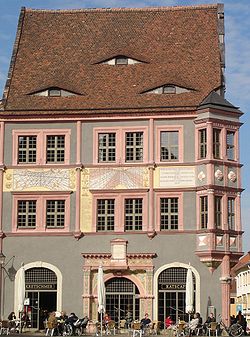Ratsapotheke (Görlitz)
| Ratsapotheke Untermarkt 24 |
|
|---|---|
 View from Untermarkt to the Ratsapotheke |
|
| Data | |
| place | Goerlitz |
| Construction year | 1550-1552 |
| Coordinates | 51 ° 9 '25 " N , 14 ° 59' 28.6" E |
The Ratsapotheke , also known as the Struve Pharmacy , is one of the most famous town houses in the historic old town of Görlitz . The renaissance building is located on the northern part of the Untermarkt and is the corner house facing the Peterstraße. On the side facing the Lower Market, the house bears two sundials by Zacharias Scultetus - a brother of the Görlitz astronomer and mathematician Bartholomäus Scultetus . The renaissance gable of the house faces Peterstraße.
history
The Gothic predecessor building was rebuilt and modernized in the Renaissance style by the Görlitz city master builder Wendel Roskopf the Younger between 1550 and 1552 for the businessman Hans Hoffmann.
The astronomical drawings between the first and second floors on the south facade also date from 1550. They were drawn by Zacharias Scultetus . The name Ratsapotheke is derived from the town hall pharmacy, which was opened on July 29, 1771 by its owner Benjamin August Struve (1721–1789), who bought it in 1755, from the town hall on the corner of Apothekergasse to the former brewery at No. 267 on Häringsmarkt , now Untermarkt 24 and Peterstraße 1, was relocated. Struve had owned the house since 1770. He was followed by his son Christian August Struve (1767-1807) and the city councilor Alexander Struve, after whom Struvestraße is named. In 1771, extensive renovation work also took place on the ground floor. This also created the basket arches on the side facing the square on the right and left of the entrance portal. From 1789 to 1830 the pharmacy was run by the tenants Thieme and Pape.
Until 1832 the town hall pharmacy was the only pharmacy in the city. After the Second World War , a public children's library, the first urban youth club and an artist workshop moved into the ground floor. The other floors were occupied by families. Extensive renovation work in and on the building began in 1999. As part of the renovation work, the old ornate entrance portal was also exposed. The portal had previously been walled up for decades. The entrance was to the right of the portal. A plaque above the portal commemorates the former owner and pharmacist Christian August Struve.
Sundials and writings
Two sundials by Zacharias Scultetus are depicted above the first floor, the left of the two being titled Solarium . It shows different types of hours with its various lines. The gray lines pointing towards the shadow hand represent the civil hours . It starts at seven in the morning on the left and ends at four in the afternoon on the right. The Arabic and Roman numerals and the corresponding lines running from top left to bottom right illustrate the Italian hours . The red lines show the Babylonian hours .
The adjacent sundial bears the heading Arachne and enables the planet hours to be read . The red and white areas of the clock show the sky sections with a certain zodiac sign . The group of parabolic lines represent the seasonal rise of the sun.
Below the right clock, to the left of the middle group of windows, the builder, the owner who renovated the building as well as painters and reconstructors are named with the year. The following should be read: “SCULTETUS INVENIT: 1550 - RENOVARUNT: HOFFMANN • 1558 - SCHNEIDER • 1719 - STRUVE • 1830 • 1843 • 1853 • 1867 - SCHWENDLER • 1876 - WEESE • 1889 - GERMERSHAUSEN • 1926 - BRAINICH • 1936 - RAT d . STADT • 1973 - RITTMANNSPERGER • 2000 - RECONSTRUXERUNT: DR. ZIMMERMANN • 1936 - PANNIER • 2000 - PINXERUNT: MUELLER • 1831 - DONATH • 1973 - TAUBERT, STENZEL • 2000 “.
The following is written to the right of the clock:
"HORA PLANETARIUM VIRIDI EST EXPRESSA
COLORE
ET RUBRA OSCENDUNT ALBAQUE PLANA
DOMUS.
STAMINE YOUR NIGRO CONTEXTA ASCEN:
SIO SOLIS
QUO RUTILA ASIMUTH ORDINE NORMA
SECAT. "
Web links
- Ratsapotheke on goerlitz.de
- The Görlitzer Ratsapotheke at Untermarkt 24 on Unser-goerlitz.de
- Teaching example of Silesia's Renaissance. The Ratsapotheke in Görlitz - A project sponsored by the German Foundation for Monument Protection ( Memento from July 18, 2011 in the Internet Archive ) on denkmalschutz.de
Individual evidence
- ↑ a b denkmalschutz.de: Teaching example for Silesia's Renaissance . Archived from the original on July 18, 2011 ; Retrieved February 24, 2012 .
- ↑ Werner Gottwald: On the life performance and personality of the Görlitz doctor Christian August Struve (1767–1807). In: Würzburg medical history reports. Volume 18, 1999, pp. 305-334; here: p. 305 f.
- ↑ Werner Gottwald: On the life performance and personality of the Görlitz doctor Christian August Struve (1767–1807). In: Würzburg medical history reports. Volume 18, 1999, pp. 305-334.
- ↑ Dietrich Tutzke : The importance of the Görlitz doctor Dr. Christian August Struve for spreading cowpox vaccination in Upper Lusatia from 1800–1807. In: Contributions to the history of pharmacy and its neighboring areas. Volume 2, 1956, pp. 76-91.
- ^ Richard Jecht: History of the City of Görlitz, Volume 1, Half Volume 2 . 1st edition. Verlag des Magistrates der Stadt Görlitz, 1934, p. 360 f .
- ↑ a b c d Unser-goerlitz.de: The Görlitzer Ratsapotheke at Untermarkt 24 . (No longer available online.) Archived from the original on January 5, 2010 ; Retrieved February 24, 2012 . Info: The archive link was inserted automatically and has not yet been checked. Please check the original and archive link according to the instructions and then remove this notice.
- ↑ read: ascensio


